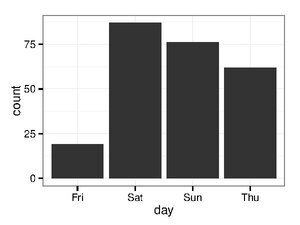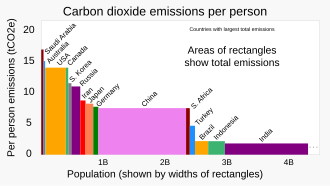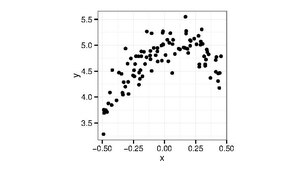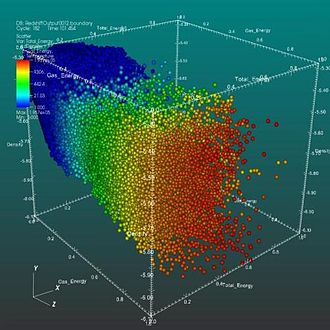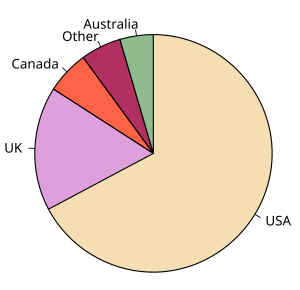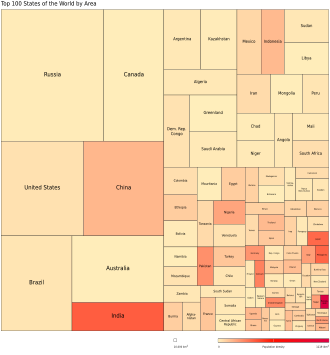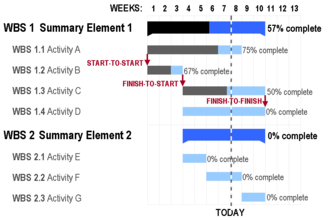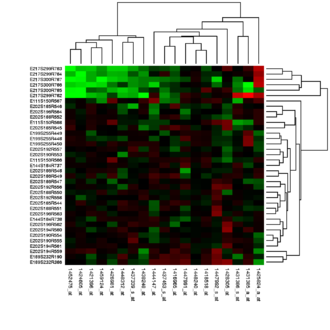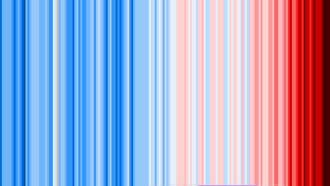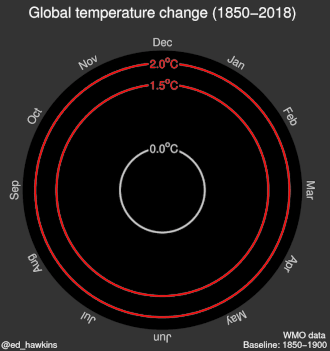Difference between revisions of "Display of Categorical Data"
(Created page with "== Categorical variable == In statistics, a '''categorical variable''' (also called '''qualitative variable''') is a variable that can take on one of a limited, and usually f...") |
|||
| (3 intermediate revisions by the same user not shown) | |||
| Line 16: | Line 16: | ||
*The type of a rock: igneous, sedimentary or metamorphic. | *The type of a rock: igneous, sedimentary or metamorphic. | ||
*The identity of a particular word (e.g., in a language model): One of ''V'' possible choices, for a vocabulary of size ''V''. | *The identity of a particular word (e.g., in a language model): One of ''V'' possible choices, for a vocabulary of size ''V''. | ||
| + | |||
| + | == Data visualization == | ||
| + | |||
| + | '''Data visualization''' (often abbreviated '''data viz''') is an interdisciplinary field that deals with the graphic representation of data. It is a particularly efficient way of communicating when the data is numerous as for example a time series. | ||
| + | |||
| + | From an academic point of view, this representation can be considered as a mapping between the original data (usually numerical) and graphic elements (for example, lines or points in a chart). The mapping determines how the attributes of these elements vary according to the data. In this light, a bar chart is a mapping of the length of a bar to a magnitude of a variable. Since the graphic design of the mapping can adversely affect the readability of a chart, mapping is a core competency of Data visualization. | ||
| + | |||
| + | Data visualization has its roots in the field of Statistics and is therefore generally considered a branch of Descriptive Statistics. However, because both design skills and statistical and computing skills are required to visualize effectively, it is argued by some authors that it is both an Art and a Science. | ||
| + | |||
| + | Research into how people read and misread various types of visualizations is helping to determine what types and features of visualizations are most understandable and effective in conveying information. | ||
| + | |||
| + | To communicate information clearly and efficiently, data visualization uses statistical graphics, plots, information graphics and other tools. Numerical data may be encoded using dots, lines, or bars, to visually communicate a quantitative message. Effective visualization helps users analyze and reason about data and evidence. It makes complex data more accessible, understandable, and usable. Users may have particular analytical tasks, such as making comparisons or understanding causality, and the design principle of the graphic (i.e., showing comparisons or showing causality) follows the task. Tables are generally used where users will look up a specific measurement, while charts of various types are used to show patterns or relationships in the data for one or more variables. | ||
| + | |||
| + | Data visualization refers to the techniques used to communicate data or information by encoding it as visual objects (e.g., points, lines, or bars) contained in graphics. The goal is to communicate information clearly and efficiently to users. It is one of the steps in data analysis or data science. According to Vitaly Friedman (2008) the "main goal of data visualization is to communicate information clearly and effectively through graphical means. It doesn't mean that data visualization needs to look boring to be functional or extremely sophisticated to look beautiful. To convey ideas effectively, both aesthetic form and functionality need to go hand in hand, providing insights into a rather sparse and complex data set by communicating its key aspects in a more intuitive way. Yet designers often fail to achieve a balance between form and function, creating gorgeous data visualizations which fail to serve their main purpose — to communicate information". | ||
| + | |||
| + | Indeed, Fernanda Viegas and Martin M. Wattenberg suggested that an ideal visualization should not only communicate clearly, but stimulate viewer engagement and attention. | ||
| + | |||
| + | Data visualization is closely related to information graphics, information visualization, scientific visualization, exploratory data analysis and statistical graphics. In the new millennium, data visualization has become an active area of research, teaching and development. According to Post et al. (2002), it has united scientific and information visualization. | ||
| + | |||
| + | In the commercial environment data visualization is often referred to as dashboards. Infographics are another very common form of data visualization. | ||
| + | |||
| + | ===Characteristics of effective graphical displays=== | ||
| + | [[File:Minard.png|thumb|upright=2|Charles Joseph Minard's 1869 diagram of Napoleonic France's invasion of Russia, an early example of an information graphic]] | ||
| + | |||
| + | Professor Edward Tufte explained that users of information displays are executing particular ''analytical tasks'' such as making comparisons. The ''design principle'' of the information graphic should support the analytical task. As William Cleveland and Robert McGill show, different graphical elements accomplish this more or less effectively. For example, dot plots and bar charts outperform pie charts. | ||
| + | |||
| + | In his 1983 book ''The Visual Display of Quantitative Information'', Edward Tufte defines 'graphical displays' and principles for effective graphical display in the following passage: "Excellence in statistical graphics consists of complex ideas communicated with clarity, precision, and efficiency. Graphical displays should: | ||
| + | |||
| + | "Excellence in statistical graphics consists of complex ideas communicated with clarity, precision, and efficiency. Graphical displays should: | ||
| + | *show the data | ||
| + | *induce the viewer to think about the substance rather than about methodology, graphic design, the technology of graphic production, or something else | ||
| + | * avoid distorting what the data has to say | ||
| + | *present many numbers in a small space | ||
| + | *make large data sets coherent | ||
| + | *encourage the eye to compare different pieces of data | ||
| + | *reveal the data at several levels of detail, from a broad overview to the fine structure | ||
| + | *serve a reasonably clear purpose: description, exploration, tabulation, or decoration | ||
| + | *be closely integrated with the statistical and verbal descriptions of a data set. | ||
| + | Graphics ''reveal'' data. Indeed graphics can be more precise and revealing than conventional statistical computations." | ||
| + | |||
| + | For example, the Minard diagram shows the losses suffered by Napoleon's army in the 1812–1813 period. Six variables are plotted: the size of the army, its location on a two-dimensional surface (x and y), time, the direction of movement, and temperature. The line width illustrates a comparison (size of the army at points in time), while the temperature axis suggests a cause of the change in army size. This multivariate display on a two-dimensional surface tells a story that can be grasped immediately while identifying the source data to build credibility. Tufte wrote in 1983 that: "It may well be the best statistical graphic ever drawn." | ||
| + | |||
| + | Not applying these principles may result in misleading graphs, distorting the message, or supporting an erroneous conclusion. According to Tufte, chartjunk refers to the extraneous interior decoration of the graphic that does not enhance the message or gratuitous three-dimensional or perspective effects. Needlessly separating the explanatory key from the image itself, requiring the eye to travel back and forth from the image to the key, is a form of "administrative debris." The ratio of "data to ink" should be maximized, erasing non-data ink where feasible. | ||
| + | |||
| + | The Congressional Budget Office summarized several best practices for graphical displays in a June 2014 presentation. These included: a) Knowing your audience; b) Designing graphics that can stand alone outside the report's context; and c) Designing graphics that communicate the key messages in the report. | ||
| + | |||
| + | ===Quantitative messages=== | ||
| + | [[File:Total Revenues and Outlays as Percent GDP 2013.png|thumb|upright=1.75|A time series illustrated with a line chart demonstrating trends in U.S. federal spending and revenue over time]] | ||
| + | [[File:U.S. Phillips Curve 2000 to 2013.png|thumb|upright=1.5|A scatterplot illustrating negative correlation between two variables (inflation and unemployment) measured at points in time]] | ||
| + | |||
| + | Author Stephen Few described eight types of quantitative messages that users may attempt to understand or communicate from a set of data and the associated graphs used to help communicate the message: | ||
| + | |||
| + | #Time-series: A single variable is captured over a period of time, such as the unemployment rate over a 10-year period. A line chart may be used to demonstrate the trend. | ||
| + | #Ranking: Categorical subdivisions are ranked in ascending or descending order, such as a ranking of sales performance (the ''measure'') by sales persons (the ''category'', with each sales person a ''categorical subdivision'') during a single period. A bar chart may be used to show the comparison across the sales persons. | ||
| + | #Part-to-whole: Categorical subdivisions are measured as a ratio to the whole (i.e., a percentage out of 100%). A pie chart or bar chart can show the comparison of ratios, such as the market share represented by competitors in a market. | ||
| + | #Deviation: Categorical subdivisions are compared against a reference, such as a comparison of actual vs. budget expenses for several departments of a business for a given time period. A bar chart can show comparison of the actual versus the reference amount. | ||
| + | #Frequency distribution: Shows the number of observations of a particular variable for given interval, such as the number of years in which the stock market return is between intervals such as 0-10%, 11-20%, etc. A histogram, a type of bar chart, may be used for this analysis. A boxplot helps visualize key statistics about the distribution, such as median, quartiles, outliers, etc. | ||
| + | #Correlation: Comparison between observations represented by two variables (X,Y) to determine if they tend to move in the same or opposite directions. For example, plotting unemployment (X) and inflation (Y) for a sample of months. A scatter plot is typically used for this message. | ||
| + | #Nominal comparison: Comparing categorical subdivisions in no particular order, such as the sales volume by product code. A bar chart may be used for this comparison. | ||
| + | #Geographic or geospatial: Comparison of a variable across a map or layout, such as the unemployment rate by state or the number of persons on the various floors of a building. A cartogram is a typical graphic used. | ||
| + | |||
| + | Analysts reviewing a set of data may consider whether some or all of the messages and graphic types above are applicable to their task and audience. The process of trial and error to identify meaningful relationships and messages in the data is part of exploratory data analysis. | ||
| + | |||
| + | ===Visual perception and data visualization=== | ||
| + | A human can distinguish differences in line length, shape, orientation, distances, and color (hue) readily without significant processing effort; these are referred to as "pre-attentive attributes". For example, it may require significant time and effort ("attentive processing") to identify the number of times the digit "5" appears in a series of numbers; but if that digit is different in size, orientation, or color, instances of the digit can be noted quickly through pre-attentive processing. | ||
| + | |||
| + | Compelling graphics take advantage of pre-attentive processing and attributes and the relative strength of these attributes. For example, since humans can more easily process differences in line length than surface area, it may be more effective to use a bar chart (which takes advantage of line length to show comparison) rather than pie charts (which use surface area to show comparison). | ||
| + | |||
| + | ==== Human perception/cognition and data visualization ==== | ||
| + | Almost all data visualizations are created for human consumption. Knowledge of human perception and cognition is necessary when designing intuitive visualizations. Cognition refers to processes in human beings like perception, attention, learning, memory, thought, concept formation, reading, and problem solving. Human visual processing is efficient in detecting changes and making comparisons between quantities, sizes, shapes and variations in lightness. When properties of symbolic data are mapped to visual properties, humans can browse through large amounts of data efficiently. It is estimated that 2/3 of the brain's neurons can be involved in visual processing. Proper visualization provides a different approach to show potential connections, relationships, etc. which are not as obvious in non-visualized quantitative data. Visualization can become a means of data exploration. | ||
| + | |||
| + | Studies have shown individuals used on average 19% less cognitive resources, and 4.5% better able to recall details when comparing data visualization with text. | ||
| + | |||
| + | ==Techniques== | ||
| + | |||
| + | {| cellpadding="20" | ||
| + | ! width="220" | | ||
| + | ! width="120" style="text-align:left;" | Name | ||
| + | ! width="220" style="text-align:left;" | Visual dimensions | ||
| + | ! width="300" style="text-align:left;" | Description / Example usages | ||
| + | |- | ||
| + | | [[File:Tips-day-barchart.pdf|thumb|Bar chart of tips by day of week]] | ||
| + | | Bar chart | ||
| + | | | ||
| + | * length/count | ||
| + | * category | ||
| + | * color | ||
| + | | | ||
| + | * Presents categorical data with rectangular bars with heights or lengths proportional to the values that they represent. The bars can be plotted vertically or horizontally. | ||
| + | *A bar graph shows comparisons among discrete categories. One axis of the chart shows the specific categories being compared, and the other axis represents a measured value. | ||
| + | *Some bar graphs present bars clustered in groups of more than one, showing the values of more than one measured variable. These clustered groups can be differentiated using color. | ||
| + | *For example; comparison of values, such as sales performance for several persons or businesses in a single time period. | ||
| + | |- | ||
| + | | [[File:20210626 Variwide chart of greenhouse gas emissions per capita by country.svg|thumb|Variable-width bar chart relating (1) population, (2) per capita greenhouse gas emissions, and (3) total greenhouse gas emissions]] | ||
| + | | | ||
| + | Variable-width ("variwide") bar chart | ||
| + | | | ||
| + | * category (size/count/extent in first dimension) | ||
| + | * size/count/extent in second dimension | ||
| + | * size/count/extent as area of bar | ||
| + | * color | ||
| + | | | ||
| + | * Includes most features of basic bar chart, above | ||
| + | * Area of non-uniform-width bar explicitly conveys information of a third quantity that is implicitly related to first and second quantities from horizontal and vertical axes | ||
| + | |- | ||
| + | | | ||
| + | |- | ||
| + | | [[File:20211107 Projected extremes for different degrees of global warming - 3x10yr area chart - IPCC AR6 WG1 SPM.svg|thumb|(1) Frequency and (2) intensity of extreme weather events are connected in pairs of horizontal and vertical bars, respectively. Bars are distinguished by (3) color-coded primary category (degree of global warming). Additionally, a common horizontal axis may be used on (4) a secondary category (type of weather event).]] | ||
| + | | | ||
| + | Orthogonal (orthogonal composite) bar chart | ||
| + | | | ||
| + | * numerical value of first variable (extent in first dimension; superimposed horizontal bars) | ||
| + | * numerical value of second variable (extent in second dimension; conventional vertical bar chart) | ||
| + | * primary category for first and second variables (e.g., color-coded) | ||
| + | * secondary category for pairs of first and second variables (e.g., common axis) | ||
| + | | | ||
| + | * Includes most features of basic bar chart, above | ||
| + | * Pairs of numeric variables, usually color-coded, rendered in coordination with primary category and optional secondary category | ||
| + | * Variables need not be directly related in the way they are in "variwide" charts | ||
| + | |- | ||
| + | | | ||
| + | [[File:Housingprice.png|thumb|Histogram of housing prices]] | ||
| + | | Histogram | ||
| + | | | ||
| + | * bin limits | ||
| + | * count/length | ||
| + | * color | ||
| + | | | ||
| + | * An approximate representation of the distribution of numerical data. Divide the entire range of values into a series of intervals and then count how many values fall into each interval this is called binning. The bins are usually specified as consecutive, non-overlapping intervals of a variable. The bins (intervals) must be adjacent, and are often (but not required to be) of equal size. | ||
| + | *For example, determining frequency of annual stock market percentage returns within particular ranges (bins) such as 0-10%, 11-20%, etc. The height of the bar represents the number of observations (years) with a return % in the range represented by the respective bin. | ||
| + | |- | ||
| + | | | ||
| + | [[File:Scatterplot5.pdf|thumb|Basic scatterplot of two variables]] | ||
| + | | Scatter plot | ||
| + | | | ||
| + | * x position | ||
| + | * y position | ||
| + | * symbol/glyph | ||
| + | * color | ||
| + | * size | ||
| + | | | ||
| + | *Uses Cartesian coordinates to display values for typically two variables for a set of data. | ||
| + | *Points can be coded via color, shape and/or size to display additional variables. | ||
| + | *Each point on the plot has an associated x and y term that determines its location on the cartesian plane. | ||
| + | *Scatter plots are often used to highlight the correlation between variables (x and y). | ||
| + | |- | ||
| + | | | ||
| + | [[File:Scatter plot.jpg|thumb|Scatter plot]] | ||
| + | | Scatter plot (3D) | ||
| + | | | ||
| + | * position x | ||
| + | * position y | ||
| + | * position z | ||
| + | * color | ||
| + | *symbol | ||
| + | *size | ||
| + | | | ||
| + | * Similar to the 2-dimensional scatter plot above, the 3-dimensional scatter plot visualizes the relationship between typically 3 variables from a set of data. | ||
| + | * Again point can be coded via color, shape and/or size to display additional variables | ||
| + | |- border="0" | ||
| + | | [[File:Social Network Analysis Visualization.png|thumb|Network analysis]] | ||
| + | | Network | ||
| + | | | ||
| + | * nodes size | ||
| + | * nodes color | ||
| + | * ties thickness | ||
| + | * ties color | ||
| + | * spatialization | ||
| + | | | ||
| + | * Finding clusters in the network (e.g. grouping Facebook friends into different clusters). | ||
| + | * Discovering bridges (information brokers or boundary spanners) between clusters in the network | ||
| + | * Determining the most influential nodes in the network (e.g. A company wants to target a small group of people on Twitter for a marketing campaign). | ||
| + | * Finding outlier actors who do not fit into any cluster or are in the periphery of a network. | ||
| + | |- | ||
| + | | [[File:English dialects1997.svg|thumb|Pie chart]] | ||
| + | | Pie chart | ||
| + | | | ||
| + | * color | ||
| + | | | ||
| + | * Represents one categorical variable which is divided into slices to illustrate numerical proportion. In a pie chart, the arc length of each slice (and consequently its central angle and area), is proportional to the quantity it represents. | ||
| + | * For example, as shown in the graph to the right, the proportion of English native speakers worldwide | ||
| + | |- | ||
| + | | [[File:ScientificGraphSpeedVsTime.svg|thumb|Line chart]] | ||
| + | | Line chart | ||
| + | | | ||
| + | * x position | ||
| + | * y position | ||
| + | * symbol/glyph | ||
| + | * color | ||
| + | * size | ||
| + | | | ||
| + | * Represents information as a series of data points called 'markers' connected by straight line segments. | ||
| + | * Similar to a scatter plot except that the measurement points are ordered (typically by their x-axis value) and joined with straight line segments. | ||
| + | * Often used to visualize a trend in data over intervals of time – a time series – thus the line is often drawn chronologically. | ||
| + | |- | ||
| + | | [[File:LastGraph example.svg|thumb|Streamgraph]] | ||
| + | | Streamgraph | ||
| + | | | ||
| + | * width | ||
| + | * color | ||
| + | * time (flow) | ||
| + | | | ||
| + | * A type of stacked area graph which is displaced around a central axis, resulting in a flowing shape. | ||
| + | * Unlike a traditional stacked area graph in which the layers are stacked on top of an axis, in a streamgraph the layers are positioned to minimize their "wiggle". | ||
| + | * Streamgraphs display data with only positive values, and are not able to represent both negative and positive values. | ||
| + | * For example, the right visual shows the music listened to by a user over the start of the year 2012 | ||
| + | |- | ||
| + | | [[File:Top100 states area treemap pop-density.svg|thumb|Treemap]] | ||
| + | | Treemap | ||
| + | | | ||
| + | * size | ||
| + | * color | ||
| + | | | ||
| + | * Is a method for displaying hierarchical data using nested figures, usually rectangles. | ||
| + | *For example disk space by location / file type | ||
| + | |||
| + | |- | ||
| + | | [[File:GanttChartAnatomy.png|thumb|Gantt chart]] | ||
| + | | Gantt chart | ||
| + | | | ||
| + | * color | ||
| + | * time (flow) | ||
| + | | | ||
| + | * Type of bar chart that illustrates a project schedule | ||
| + | *Modern Gantt charts also show the dependency relationships between activities and current schedule status. | ||
| + | *For example used in project planning | ||
| + | |- | ||
| + | | [[File:Heatmap.png|thumb|Heat map]] | ||
| + | | Heat map | ||
| + | | | ||
| + | * color | ||
| + | *categorical variable | ||
| + | | | ||
| + | * Represents the magnitude of a phenomenon as color in two dimensions. | ||
| + | *There are two categories of heat maps: | ||
| + | **cluster heat map: where magnitudes are laid out into a matrix of fixed cell size whose rows and columns are categorical data. For example, the graph to the right. | ||
| + | **spatial heat map: where no matrix of fixed cell size for example a heat-map. For example, a heat map showing population densities displayed on a geographical map | ||
| + | |- | ||
| + | |[[File:20190705 Warming stripes - Berkeley Earth (world) - avg above- and below-ice readings.png|thumb|Stripe graphic]] | ||
| + | |Stripe graphic | ||
| + | | | ||
| + | * x position | ||
| + | * color | ||
| + | | | ||
| + | * Uses a series of colored stripes chronologically ordered to visually portray long-term temperature trends. | ||
| + | *Portrays a single variable—prototypically ''temperature over time'' to portray global warming | ||
| + | * Deliberately minimalist—with no technical indicia—to communicate intuitively with non-scientists | ||
| + | * Can be "stacked" to represent plural series ([[:File:20190909_STACKED_country_warming_stripes_AND_global_average_(1901-_).png |example]]) | ||
| + | |- | ||
| + | |[[File:5 9 16 Andrea TempSpiralEdHawkins.gif|thumb|Animated spiral graphic]] | ||
| + | |Animated spiral graphic | ||
| + | | | ||
| + | * radial distance (dependent variable) | ||
| + | * rotating angle (cycling through months) | ||
| + | * color (passing years) | ||
| + | | | ||
| + | * Portrays a single dependent variable—prototypically ''temperature over time'' to portray global warming | ||
| + | * Dependent variable is progressively plotted along a continuous "spiral" determined as a function of (a) constantly rotating angle (twelve months per revolution) and (b) evolving color (color changes over passing years) | ||
| + | |- | ||
| + | |[[File:Michelsonmorley-boxplot.svg|thumb|Box and whisker plot]] | ||
| + | |Box and Whisker Plot | ||
| + | | | ||
| + | * x axis | ||
| + | *y axis | ||
| + | | | ||
| + | * A method for graphically depicting groups of numerical data through their quartiles. | ||
| + | *Box plots may also have lines extending from the boxes (''whiskers'') indicating variability outside the upper and lower quartiles. | ||
| + | *Outliers may be plotted as individual points. | ||
| + | *The two boxes graphed on top of each other represent the middle 50% of the data,, with the line separating the two boxes identifying the median data value and the top and bottom edges of the boxes represent the 75th and 25th percentile data points respectively. | ||
| + | *Box plots are non-parametric: they display variation in samples of a statistical population without making any assumptions of the underlying statistical distribution, thus are useful for getting an initial understanding of a data set. For example, comparing the distribution of ages between a group of people (e.g. male and females). | ||
| + | |- | ||
| + | |[[File:LampFlowchart.svg|thumb|Flowchart]] | ||
| + | |Flowchart | ||
| + | | | ||
| + | * workflow or process | ||
| + | | | ||
| + | * Represents a workflow, process or a step-by-step approach to solving a task. | ||
| + | *The flowchart shows the steps as boxes of various kinds, and their order by connecting the boxes with arrows. | ||
| + | *For example, outlying the actions to undertake if a lamp is not working, as shown in the diagram to the right. | ||
| + | |- | ||
| + | |[[File:MER Star Plot.gif|thumb|Radar chart]] | ||
| + | |Radar chart | ||
| + | | | ||
| + | * attributes | ||
| + | *value assigned to attributes | ||
| + | | | ||
| + | * Displays multivariate data in the form of a two-dimensional chart of three or more quantitative variables represented on axes starting from the same point. | ||
| + | *The relative position and angle of the axes is typically uninformative, but various heuristics, such as algorithms that plot data as the maximal total area, can be applied to sort the variables (axes) into relative positions that reveal distinct correlations, trade-offs, and a multitude of other comparative measures. | ||
| + | *For example, comparing attributes/skills (e.g. communication, analytical, IT skills) learnt across different a university degrees (e.g. mathematics, economics, psychology) | ||
| + | |- | ||
| + | |[[File:Venn diagram gr la ru.svg|thumb|Venn diagram]] | ||
| + | |Venn diagram | ||
| + | | | ||
| + | * ''all'' possible logical relations between a finite collection of different sets. | ||
| + | | | ||
| + | * Shows ''all'' possible logical relations between a finite collection of different sets. | ||
| + | *These diagrams depict elements as points in the plane, and sets as regions inside closed curves. | ||
| + | *A Venn diagram consists of multiple overlapping closed curves, usually circles, each representing a set. | ||
| + | *The points inside a curve labelled ''S'' represent elements of the set ''S'', while points outside the boundary represent elements not in the set ''S''. This lends itself to intuitive visualizations; for example, the set of all elements that are members of both sets ''S'' and ''T'', denoted ''S'' ∩ ''T'' and read "the intersection of ''S'' and ''T''", is represented visually by the area of overlap of the regions ''S'' and ''T''. In Venn diagrams, the curves are overlapped in every possible way, showing all possible relations between the sets. | ||
| + | |- | ||
| + | | | ||
| + | [[File:AirMerIconographyCorrelation.jpg|thumb|Iconography of correlations]] | ||
| + | | Iconography of correlations | ||
| + | | | ||
| + | * No axis | ||
| + | * Solid line | ||
| + | * dotted line | ||
| + | * color | ||
| + | | | ||
| + | * Exploratory data analysis. | ||
| + | * Replace a correlation matrix by a diagram where the “remarkable” correlations are represented by a solid line (positive correlation), or a dotted line (negative correlation). | ||
| + | * Points can be coded via color. | ||
| + | |- | ||
| + | |} | ||
== Licensing == | == Licensing == | ||
Latest revision as of 23:28, 17 December 2021
Contents
Categorical variable
In statistics, a categorical variable (also called qualitative variable) is a variable that can take on one of a limited, and usually fixed, number of possible values, assigning each individual or other unit of observation to a particular group or nominal category on the basis of some qualitative property. In computer science and some branches of mathematics, categorical variables are referred to as enumerations or enumerated types. Commonly (though not in this article), each of the possible values of a categorical variable is referred to as a level. The probability distribution associated with a random categorical variable is called a categorical distribution.
Categorical data is the statistical data type consisting of categorical variables or of data that has been converted into that form, for example as grouped data. More specifically, categorical data may derive from observations made of qualitative data that are summarised as counts or cross tabulations, or from observations of quantitative data grouped within given intervals. Often, purely categorical data are summarised in the form of a contingency table. However, particularly when considering data analysis, it is common to use the term "categorical data" to apply to data sets that, while containing some categorical variables, may also contain non-categorical variables.
A categorical variable that can take on exactly two values is termed a binary variable or a dichotomous variable; an important special case is the Bernoulli variable. Categorical variables with more than two possible values are called polytomous variables; categorical variables are often assumed to be polytomous unless otherwise specified. Discretization is treating continuous data as if it were categorical. Dichotomization is treating continuous data or polytomous variables as if they were binary variables. Regression analysis often treats category membership with one or more quantitative dummy variables.
Examples of categorical variables
Examples of values that might be represented in a categorical variable:
- The roll of a six-sided die: possible outcomes are 1,2,3,4,5, or 6.
- Demographic information of a population: gender, disease status.
- The blood type of a person: A, B, AB or O.
- The political party that a voter might vote for, e. g. Green Party, Christian Democrat, Social Democrat, etc.
- The type of a rock: igneous, sedimentary or metamorphic.
- The identity of a particular word (e.g., in a language model): One of V possible choices, for a vocabulary of size V.
Data visualization
Data visualization (often abbreviated data viz) is an interdisciplinary field that deals with the graphic representation of data. It is a particularly efficient way of communicating when the data is numerous as for example a time series.
From an academic point of view, this representation can be considered as a mapping between the original data (usually numerical) and graphic elements (for example, lines or points in a chart). The mapping determines how the attributes of these elements vary according to the data. In this light, a bar chart is a mapping of the length of a bar to a magnitude of a variable. Since the graphic design of the mapping can adversely affect the readability of a chart, mapping is a core competency of Data visualization.
Data visualization has its roots in the field of Statistics and is therefore generally considered a branch of Descriptive Statistics. However, because both design skills and statistical and computing skills are required to visualize effectively, it is argued by some authors that it is both an Art and a Science.
Research into how people read and misread various types of visualizations is helping to determine what types and features of visualizations are most understandable and effective in conveying information.
To communicate information clearly and efficiently, data visualization uses statistical graphics, plots, information graphics and other tools. Numerical data may be encoded using dots, lines, or bars, to visually communicate a quantitative message. Effective visualization helps users analyze and reason about data and evidence. It makes complex data more accessible, understandable, and usable. Users may have particular analytical tasks, such as making comparisons or understanding causality, and the design principle of the graphic (i.e., showing comparisons or showing causality) follows the task. Tables are generally used where users will look up a specific measurement, while charts of various types are used to show patterns or relationships in the data for one or more variables.
Data visualization refers to the techniques used to communicate data or information by encoding it as visual objects (e.g., points, lines, or bars) contained in graphics. The goal is to communicate information clearly and efficiently to users. It is one of the steps in data analysis or data science. According to Vitaly Friedman (2008) the "main goal of data visualization is to communicate information clearly and effectively through graphical means. It doesn't mean that data visualization needs to look boring to be functional or extremely sophisticated to look beautiful. To convey ideas effectively, both aesthetic form and functionality need to go hand in hand, providing insights into a rather sparse and complex data set by communicating its key aspects in a more intuitive way. Yet designers often fail to achieve a balance between form and function, creating gorgeous data visualizations which fail to serve their main purpose — to communicate information".
Indeed, Fernanda Viegas and Martin M. Wattenberg suggested that an ideal visualization should not only communicate clearly, but stimulate viewer engagement and attention.
Data visualization is closely related to information graphics, information visualization, scientific visualization, exploratory data analysis and statistical graphics. In the new millennium, data visualization has become an active area of research, teaching and development. According to Post et al. (2002), it has united scientific and information visualization.
In the commercial environment data visualization is often referred to as dashboards. Infographics are another very common form of data visualization.
Characteristics of effective graphical displays
Professor Edward Tufte explained that users of information displays are executing particular analytical tasks such as making comparisons. The design principle of the information graphic should support the analytical task. As William Cleveland and Robert McGill show, different graphical elements accomplish this more or less effectively. For example, dot plots and bar charts outperform pie charts.
In his 1983 book The Visual Display of Quantitative Information, Edward Tufte defines 'graphical displays' and principles for effective graphical display in the following passage: "Excellence in statistical graphics consists of complex ideas communicated with clarity, precision, and efficiency. Graphical displays should:
"Excellence in statistical graphics consists of complex ideas communicated with clarity, precision, and efficiency. Graphical displays should:
- show the data
- induce the viewer to think about the substance rather than about methodology, graphic design, the technology of graphic production, or something else
- avoid distorting what the data has to say
- present many numbers in a small space
- make large data sets coherent
- encourage the eye to compare different pieces of data
- reveal the data at several levels of detail, from a broad overview to the fine structure
- serve a reasonably clear purpose: description, exploration, tabulation, or decoration
- be closely integrated with the statistical and verbal descriptions of a data set.
Graphics reveal data. Indeed graphics can be more precise and revealing than conventional statistical computations."
For example, the Minard diagram shows the losses suffered by Napoleon's army in the 1812–1813 period. Six variables are plotted: the size of the army, its location on a two-dimensional surface (x and y), time, the direction of movement, and temperature. The line width illustrates a comparison (size of the army at points in time), while the temperature axis suggests a cause of the change in army size. This multivariate display on a two-dimensional surface tells a story that can be grasped immediately while identifying the source data to build credibility. Tufte wrote in 1983 that: "It may well be the best statistical graphic ever drawn."
Not applying these principles may result in misleading graphs, distorting the message, or supporting an erroneous conclusion. According to Tufte, chartjunk refers to the extraneous interior decoration of the graphic that does not enhance the message or gratuitous three-dimensional or perspective effects. Needlessly separating the explanatory key from the image itself, requiring the eye to travel back and forth from the image to the key, is a form of "administrative debris." The ratio of "data to ink" should be maximized, erasing non-data ink where feasible.
The Congressional Budget Office summarized several best practices for graphical displays in a June 2014 presentation. These included: a) Knowing your audience; b) Designing graphics that can stand alone outside the report's context; and c) Designing graphics that communicate the key messages in the report.
Quantitative messages
Author Stephen Few described eight types of quantitative messages that users may attempt to understand or communicate from a set of data and the associated graphs used to help communicate the message:
- Time-series: A single variable is captured over a period of time, such as the unemployment rate over a 10-year period. A line chart may be used to demonstrate the trend.
- Ranking: Categorical subdivisions are ranked in ascending or descending order, such as a ranking of sales performance (the measure) by sales persons (the category, with each sales person a categorical subdivision) during a single period. A bar chart may be used to show the comparison across the sales persons.
- Part-to-whole: Categorical subdivisions are measured as a ratio to the whole (i.e., a percentage out of 100%). A pie chart or bar chart can show the comparison of ratios, such as the market share represented by competitors in a market.
- Deviation: Categorical subdivisions are compared against a reference, such as a comparison of actual vs. budget expenses for several departments of a business for a given time period. A bar chart can show comparison of the actual versus the reference amount.
- Frequency distribution: Shows the number of observations of a particular variable for given interval, such as the number of years in which the stock market return is between intervals such as 0-10%, 11-20%, etc. A histogram, a type of bar chart, may be used for this analysis. A boxplot helps visualize key statistics about the distribution, such as median, quartiles, outliers, etc.
- Correlation: Comparison between observations represented by two variables (X,Y) to determine if they tend to move in the same or opposite directions. For example, plotting unemployment (X) and inflation (Y) for a sample of months. A scatter plot is typically used for this message.
- Nominal comparison: Comparing categorical subdivisions in no particular order, such as the sales volume by product code. A bar chart may be used for this comparison.
- Geographic or geospatial: Comparison of a variable across a map or layout, such as the unemployment rate by state or the number of persons on the various floors of a building. A cartogram is a typical graphic used.
Analysts reviewing a set of data may consider whether some or all of the messages and graphic types above are applicable to their task and audience. The process of trial and error to identify meaningful relationships and messages in the data is part of exploratory data analysis.
Visual perception and data visualization
A human can distinguish differences in line length, shape, orientation, distances, and color (hue) readily without significant processing effort; these are referred to as "pre-attentive attributes". For example, it may require significant time and effort ("attentive processing") to identify the number of times the digit "5" appears in a series of numbers; but if that digit is different in size, orientation, or color, instances of the digit can be noted quickly through pre-attentive processing.
Compelling graphics take advantage of pre-attentive processing and attributes and the relative strength of these attributes. For example, since humans can more easily process differences in line length than surface area, it may be more effective to use a bar chart (which takes advantage of line length to show comparison) rather than pie charts (which use surface area to show comparison).
Human perception/cognition and data visualization
Almost all data visualizations are created for human consumption. Knowledge of human perception and cognition is necessary when designing intuitive visualizations. Cognition refers to processes in human beings like perception, attention, learning, memory, thought, concept formation, reading, and problem solving. Human visual processing is efficient in detecting changes and making comparisons between quantities, sizes, shapes and variations in lightness. When properties of symbolic data are mapped to visual properties, humans can browse through large amounts of data efficiently. It is estimated that 2/3 of the brain's neurons can be involved in visual processing. Proper visualization provides a different approach to show potential connections, relationships, etc. which are not as obvious in non-visualized quantitative data. Visualization can become a means of data exploration.
Studies have shown individuals used on average 19% less cognitive resources, and 4.5% better able to recall details when comparing data visualization with text.
Techniques
| Name | Visual dimensions | Description / Example usages | |
|---|---|---|---|
| Bar chart |
|
| |
|
Variable-width ("variwide") bar chart |
|
| |
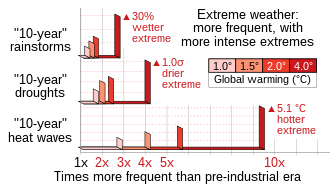 (1) Frequency and (2) intensity of extreme weather events are connected in pairs of horizontal and vertical bars, respectively. Bars are distinguished by (3) color-coded primary category (degree of global warming). Additionally, a common horizontal axis may be used on (4) a secondary category (type of weather event). |
Orthogonal (orthogonal composite) bar chart |
|
|
| Histogram |
|
| |
| Scatter plot |
|
| |
| Scatter plot (3D) |
|
| |
| Network |
|
| |
| Pie chart |
|
| |
| Line chart |
|
| |
| Streamgraph |
|
| |
| Treemap |
|
| |
| Gantt chart |
|
| |
| Heat map |
|
| |
| Stripe graphic |
|
| |
| Animated spiral graphic |
|
| |
| Box and Whisker Plot |
|
| |
| Flowchart |
|
| |
| Radar chart |
|
| |
| Venn diagram |
|
| |
| Iconography of correlations |
|
|
Licensing
Content obtained and/or adapted from:
- Categorical variable, Wikipedia under a CC BY-SA license
- Data visualization, Wikipedia under a CC BY-SA license



